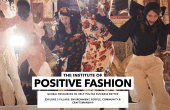“Only with technology can you create new things in fashion. Everything else has been done.”
-Hussein Chalayan
Yesterday I took part in a thought-provoking workshop organised by the Prime Minister’s Council for Science and Technology, on the subject of how technologies can affect our wellbeing throughout our lives and how they are going to evolve in the future.
There was a particular focus on the rise of our ageing population and interesting statistics suggesting that babies born today can expect to live to around 103 years old.
This is surely going to present society with a new set of challenges which the fashion industry needs to embrace, as it offers huge opportunities.
I was at the event to offer a piece on ‘wearable’ technology. Fashion always needs to be at the heart of social, political and environmental discussion, as what we wear affects almost all of us and in so many ways. Fashion can and should play a significant part in future technological innovation.
At LCF we have already begun to explore the possibilities of ‘wearable’ technology. Our Digital Anthropology Institute are involved in some key projects that demonstrate the potential for fashion to embrace technology. Recently, seven MA students created and coded:
-A garment washing system which detects the level of pollution in your clothes and links to your wardrobe and washing machine.
– A performance music jacket which allows remote users to ‘feel’ performances, interact with the performer and participate.
– An artistic interpretation of a puppet which moves to data feeds, and explores notions of privacy in the digital space.
These exciting projects will be launched shortly with accompanying films, which I hope to feature on the blog too.

Richard Nicoll’s Tinker Bell Dress. Image via Fashion Innovation Agency
LCF’s Fashion Innovation Agency (FIA) has also been challenging the boundaries of technology. The FIA were involved in the creation of the Richard Nicoll Tinker Bell dress for his London Fashion Week show in 2014. Made from fibre optic fabric, activated by high intensity LED’s tailored within the dress, it created a magical digital pixie dust effect down the catwalk.
This ultimate, modern take on Tinker Bell and her signature pixie dust gave people a glimmer into the future and possibilities of wearable technology.
The Head of The FIA, Matthew Drinkwater said: “Our work has focused on changing the way that designers make their collections through smart processes and smart materials; changing the way they show those collections at London Fashion Week and ultimately changing how they sell their collections.
“What we have seen is a huge gap between designers with traditional making skills and coders/engineers with little knowledge of the fashion industry. It has been our aim to be a bridge between those areas and bring the two industries together.”
Bringing technologists and designers together to work alongside each other will be crucial in making further advances.
He says: “Collaboration remains key but even more so would be the idea of co-creation. Our greatest success was with the Tinkerbell dress where we had pattern cutters and coders/engineers working together in the same room. If we can bring the industries together under the same roof then we will begin to see genuine change in the wearables market.”

Professor Storey’s ‘Catalytic Clothing’ project. Image via UAL News Blog
Not only collaboration but also multi-skill development will be important. If our designers are aware of technological processes like coding, future collaboration can only be more effective. Our students can be inspired by the work of Professor Helen Storey, Professor of Fashion and Science at LCF. Her pioneering work over the last decade has brought the worlds of art and science together, producing hybrid projects such as her “Catalytic Clothing” which aims to purify the air around us, and products that have broken new and award winning ground.
It is certainly time for the arts and science to work together more closely to produce technological innovations which can support our future social challenges.




